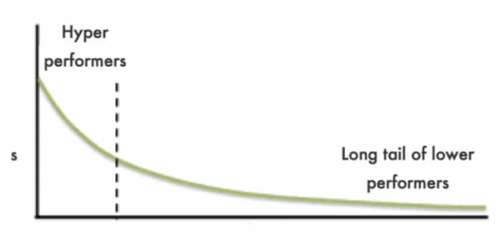 Despite Google’s efforts to always hire the best, like most organizations, they’re susceptible to hiring mistakes.
Despite Google’s efforts to always hire the best, like most organizations, they’re susceptible to hiring mistakes.
Google discovered their biggest opportunities are in their worst and best employees. Addressing these two tails provides the biggest performance improvements. In Work Rules! (Insights from Inside Google That Will Transform How You Live and Lead) Laszlo Bock shares, 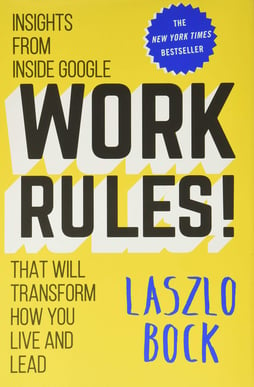 “There’s little benefit in moving a 40th percentile performer to be a 50th percentile performer but going from the 5th percentile to the 50th is major. Studying your strongest people closely and then building programs to measure and reinforce their best attributes for the entire company changes the character of your company. If you also can get those who struggle the most to be substantially better, you’ll have created a cycle of constant improvement.”
“There’s little benefit in moving a 40th percentile performer to be a 50th percentile performer but going from the 5th percentile to the 50th is major. Studying your strongest people closely and then building programs to measure and reinforce their best attributes for the entire company changes the character of your company. If you also can get those who struggle the most to be substantially better, you’ll have created a cycle of constant improvement.”
Managing Your Two Tails - Gaussian Distribution
By comparing the extremes Google found meaningful differences in behavior and outcomes.
How you gauge your team’s performance impacts how you invest in them.
Most companies suffer from following what is known as the Gaussian distribution for employee performance. (Known as the “bell curve.”)
Large organizations believe it’s best to use averages or fairness principles with all employees.
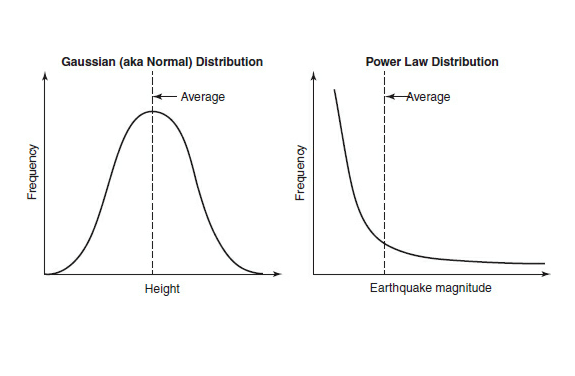 Gaussian distribution underpredicts the frequency of major physical and economic events, the dramatic span in economic outcomes for people (the expanding gap between the poor and the top 1 percent), and the exceptional human performance of a small number of individuals. These phenomena are better described by a “power law” distribution, which is compared to the Gaussian distribution. See the chart, and Why Google Quietly Uses the Power-Law Rule to Pay Its Superstar Employees 'Unfairly' to understand this principle.
Gaussian distribution underpredicts the frequency of major physical and economic events, the dramatic span in economic outcomes for people (the expanding gap between the poor and the top 1 percent), and the exceptional human performance of a small number of individuals. These phenomena are better described by a “power law” distribution, which is compared to the Gaussian distribution. See the chart, and Why Google Quietly Uses the Power-Law Rule to Pay Its Superstar Employees 'Unfairly' to understand this principle.
By managing people using a normal distribution, most people get labeled as average, while the two tails of weak and strong performers are pushed out to the sides. The tails aren’t as symmetrical as when you look at height, because failing employees get fired and the worst don’t even make it in the door, so the left tail is cut short.
Companies also treat people as if their actual output follows the same distribution. That’s an error.
Most companies get rid of the “bottom tail” performers, who live in a purgatory of failure and fear they could be fired at any moment.
Worse, in today’s job market, many companies keep their bottom tail (They can’t find replacements), and their top tail leaves for better opportunities because they’re not being rewarded for the level of their performance.
Identify Your Worst Performers
Watch Laszlo Bock: A Method for Dealing with Low Performers
Google engages in compassionate pragmatism. Let those at the bottom of the performance distribution know it. Do not tie it directly to pay or career outcomes. Instead, alert and motivate them as positively as possible. Moving someone from the lowest performance to a higher performance level makes a significant impact on your business. Making someone aware of their poor performance, often is enough to get them to improve.
If you believe people are fundamentally good and worthy of trust, you must be honest and transparent with them. This includes telling them when they lag behind in their performance.
A mission-driven, purposeful workplace requires you approach people with sensitivity. Most people who are performing poorly know it and want to get better. It’s important to give them a chance.
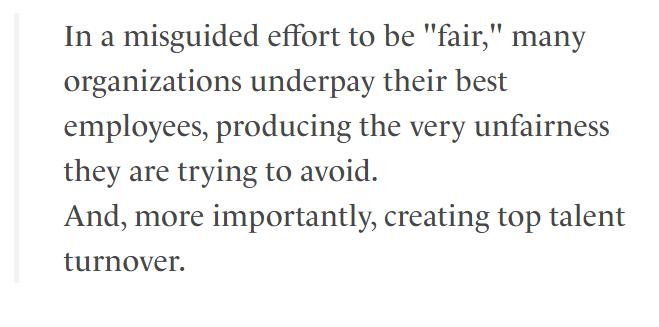 Help those struggling the most become substantially better. You’ll create a cycle of constant improvement. Investing in the bottom tail of the distribution improves your team a lot. People either improve dramatically or leave and succeed elsewhere.
Help those struggling the most become substantially better. You’ll create a cycle of constant improvement. Investing in the bottom tail of the distribution improves your team a lot. People either improve dramatically or leave and succeed elsewhere.
Study Your Best Performers
Google’s data discovered top performers find it easier to get things done, feel more valued, feel that their work is more meaningful, and leave the company at one-fifth the rate that our lowest performers do. Why?
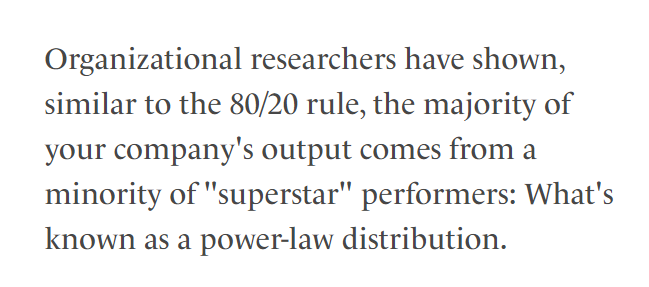 Because top performers live in a virtuous cycle of great output, great feedback, more great output, and more great feedback.
Because top performers live in a virtuous cycle of great output, great feedback, more great output, and more great feedback.
Every company has the seeds of its future success in its best people, yet most fail to study them closely.
Studying your strongest people closely and then building programs to measure and reinforce their best attributes for the entire company changes the character of your company.
If you’re in HR, involved with people, and specifically the performance level of your people, I recommend Work Rules! (Insights from Inside Google That Will Transform How You Live and Lead) by Laszlo Bock. Not because your business is like Google, but rather, because of the methodology and insights this book offers on how to manage, elevate, and treat your people.
WORK RULES…FOR MANAGING YOUR TWO TAILS
- Help those in need.
- Put your best people under a microscope.
- Use surveys and checklists to find the truth and nudge people to improve.
- Set a personal example by sharing and acting on your own feedback.
To create an environment where everyone is inspired to give their best, contact Positioning Systems today to schedule a free exploratory meeting.
Growth demands Strategic Discipline.
The training most companies invest time and money into doesn’t work. Work Rules discovered who you have trained, and how to train is more important than how much you invest in training. We’ll share how to improve employee training next blog.
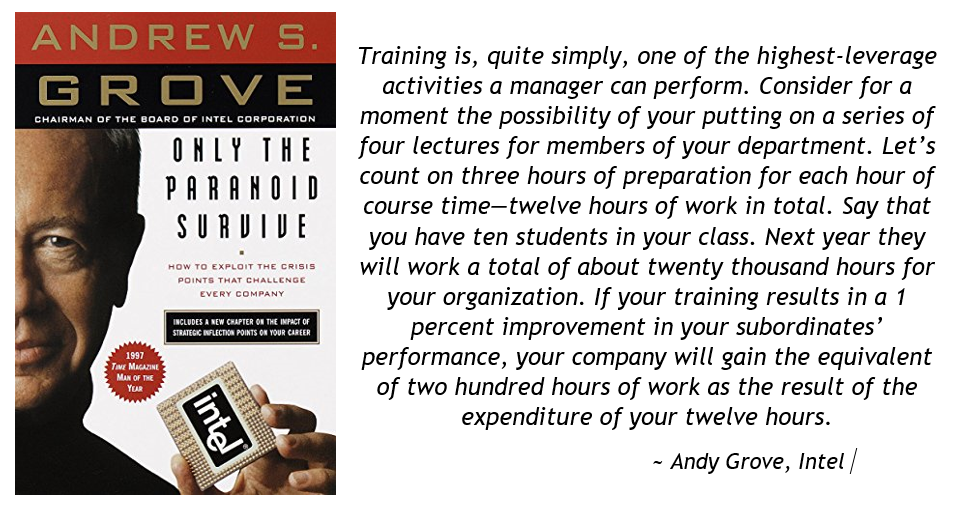 Building an enduring great organization requires disciplined people, disciplined thought, disciplined action, superior results, producing a distinctive impact on the world.
Building an enduring great organization requires disciplined people, disciplined thought, disciplined action, superior results, producing a distinctive impact on the world.
Discipline sustains momentum, over a long period of time, laying the foundations for lasting endurance.
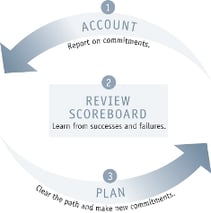 A winning habit starts with 3 Strategic Disciplines: Priority, Metrics, and Meeting Rhythms. Forecasting, accountability, individual, and team performance improve dramatically.
A winning habit starts with 3 Strategic Disciplines: Priority, Metrics, and Meeting Rhythms. Forecasting, accountability, individual, and team performance improve dramatically.
Meeting Rhythms achieve a disciplined focus on performance metrics to drive growth.
Let Positioning Systems help your business achieve these outcomes on the Four most Important Decisions your business faces:
|
DECISION |
RESULT/OUTCOME |
|
PEOPLE |
|
|
STRATEGY |
|
|
EXECUTION |
|
|
CASH |
|
Positioning Systems helps mid-sized ($5M - $250M+) businesses Scale-UP. We align your business to focus on Your One Thing! Contact dwick@positioningsystems.com to Scale Up your business! Take our Four Decisions Needs Assessment to discover how your business measures against other Scaled Up companies. We’ll contact you.
NEXT BLOG – Your Best Teachers/Trainers Already Work for You






.jpeg?width=150&height=135&name=Hand%20with%20marker%20writing%20the%20question%20Whats%20Next_%20(1).jpeg)

